
WebLetter 44
An Occasional Publication for the Home Boat Builder
Glen-L Marine Designs - 9152 Rosecrans Ave. - Bellflower, CA 90706
In this issue
- New Design?
- Designer's Notebook: Range - How far can I go on a tank of gas?
- Performance Report: Celerity
- Inboard Hardware: Making the Shaft Hole
- Feedback: Zip
- Shop Talk: Shop Storage
- Misc. Wiring Notes
- Feedback: Cabin Skiff
- Feedback: Noyo Trawler
- Recent email
GLEN-L Update
- Computers... Did you know that if you reformat the hard drive on your computer, and if you have a Zip Drive, and if there is a disk in the Zip Drive, that it will be reformatted also?
- This WebLetter is out a little sooner than the 5 weeks we usually shoot for. Thanks for all of the input. Your input is what makes this WebLetter possible.
- We have received some great photos this past month, some of which can be accessed from this WebLetter. Check the Customer Photos section for more.
- Project Registry. What do you think? In the past, I have left entries when the email address is no longer accessible, if they have something in them that might be helpful to other builders. The number of entries for certain designs is getting quite large. Should I delete entries with invalid email addresses?
Barry Witt
Editor
New Design?
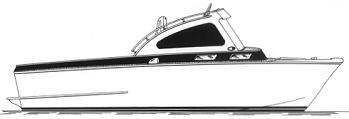
Not exactly. The Blue Fin is a design from our archives. This 19' 6" inboard cruiser has a flying bridge and plenty of open cockpit for the fisherman. It also has room for a head and space to lay down for a nap or to spend the night at the local lake. These characteristics are often asked for and are the reason that this design has been brought back to our catalog. TRhe Blue Fin is available as Plans and Patterns, but also has a Frame Kit, Fastening Kit and Fiberglass Covering Kit to make construction faster and easier. For more information about the Blue Fin, see Blue Fin in the Cruisers section of our on-line Boat Design Catalog.
Designer's Notebook: Range - How far can I go on a tank of gas?Most boat owners with a power boat of any size want to know how far they can go on a tank of fuel. Simple question? Yes and no. When all the information is available, calculations are simply made. But, there are a lot of variables that enter into the equation: speed desired, horsepower required to obtain that speed, fuel capacity and range desired. Any one of these factors can be calculated if the others are known. Let's go through the information required step by step. What speed do you wish to travel? Probably the most economical one. Motor manufacturer's have charts that show the most economical rpm's their motor will operate at. The information will also furnish the horsepower the motor develops at that speed. We have available speed charts on most designs above 20' that give the speed the boat will obtain with a given shaft horsepower. Note that's shaft horsepower, not maximum horsepower. A diesel engine has a constant and an intermittent rating. You need the constant figure; the output you can safely run the motor at all day. Gasoline motors can usually be figured to produce about 70 percent of their advertised horsepower. Again, the motor manufacturer should be able to supply the accurate figure for their motor. Fuel capacity is easy, how much tankage is available for fuel. You need to know how much fuel the motor being used will consume at the horsepower being used. Again, the manufacturer's chart would give this information, however, some rules of thumb can be substituted. A good two cycle outboard will use about one gallon of fuel for each 10 hp produced. An efficient four cycle will use about one gallon of fuel for each 13 hp used. The typical diesel, two or four cycle, will produce about 20 hp for each gallon of fuel used. Let's use a diesel powered 55' trawler with
an 840 gallon fuel tank as an example. The craft requires 150 SHP to attain a
speed of 12 knots or (12 ÷ .87) 13.8 MPH or (12 ÷ .54) 22.2
kilometers per hour. The 150 SHP is divided by 20 to determine the fuel
consumed per hour. The fuel capacity is divided by the gallons per
hour consumed or 7.5 to obtain the number of hours we can run at the noted
speed. The running hours multiplied by the speed will
provide the distance that can be traveled or... Is that then the range of this craft? Absolutely not. The figure is theoretical and assumes no rough seas, winds, currents and going from point "A" to point "B" in a straight line. A minimum of 10% extra fuel has been suggested as a compensating factor, but this is not cast in stone. Remember, if you run out of fuel, you can't walk home. The figures obtained will give an idea of the possibility of making an extended ocean going trip in a powerboat. Those of you who have an idea of gliding over the water at 25 mph to Hawaii or a voyage of similar distance isn't practical in the typical small boat. The weight of the fuel required may exceed that of the boat. Fuel is heavy; gasoline weighs about 6.2 lbs./gallon and diesel 7.1. The 940 gallons of diesel in the example above weighs almost 6000 lbs. not counting the tank weight. |
Performance Report: Celerity
Sea Trial conditions: 1-2 ft chop with occasional
big boat wake, wind 5-l0 mph. (great day for boating!)
Motor: 80 hp
Sea Trial will be a one-way 40 mile trip through mostly open water with some protected waters to an isolated Island.
The Celerity enters the water.
After checking the fuel delivery system, and looking for any possible leaks,
the boat was looked over one more time for anything that might effect the
longevity and/or safety. All wires were double checked, all bolts, steering
system, fuel system everything had to meet at least production boat standards
or better, this boat is not coming back, it will be used as a fishing boat in
remote areas where reliability and safety is a must.
The driver enters the boat and pushes off. (I am always nervous when launching a new project, I get butterflies and all that kinda stuff). The Celerity looks good in the water and we are now on our way. The course is set and we will be cruising at 27mph.
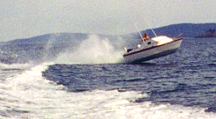
After about 15 minutes of just cruising and the butterflies are going away, the driver of the Celerity radios over to us and asks for permission to open it up and give it a real sea trial. The answer is yes and the butterflies are back. The first thing he did was a few high speed passes at full throttle. The boat looked like a missile going by, next was high speed S turns. Then as we were watching and enjoying seeing the boat do maneuvers, he started launching it off boat wakes much like a jet-ski. The little boat was sailing through the air, not even in the water. If the boat makes it through this without sinking or breaking in half I'll be a happy man. Eventually we did make it to our destination. The Celerity made it too, in one piece.
(wot@ sea level) 54mph
Best cruise 32 mph
The Celerity planes at about 15mph and gives a smooth ride along with good fuel economy. Throttle response is instantaneous.
Conclusion: The boat has a big boat feel for a little boat, I have had it in 5-6 ft seas. It's a great fishing boat with lots room for two. A 50hp motor would be more than enough power. I feel safe in this boat, it is very sea worthy and brings in a lot of fish!
Thanks again,
John Smith
Edmonds, WA.
Inboard Hardware:
|
Feedback: Zip
February 2003
Enclosed, please find photos of my pride and great joy. My Zip was almost as fun to build as she is to drive. It is my very pretty baby. I have a 1959 Mercury Mark 35A (35hp) pushing her along very nicely. It will pull a water skier, or 2 kids on a tube all day and only use $20.00 (13.00 U.S.) in fuel. In towing a skier, the boat is on plane before the skier.
I cured the skidding problem that two other builders commented on by bolting on a 1 1/2" x 84" skeg under the keel. In a real hard turn, passengers have to hang on to avoid being thrown out!
My boat is constructed with marine plywood on the bottom painted metallic brick red. All other plywood is ribbon cut mahogany, The entire hull and deck is covered in 4 oz. Deck cloth and topped with automotive clear coat, which is in turn coated with the most expensive polish I could find. All other structural wood was birch, which was custom cut and milled. For the trim I fabricated and polished stainless steel to a mirror finish. I also designed and selected the upholstery but had it custom sewn. The sewing is the only work I didn't do. The windshield is a story in itself It was purchased ($18 can.) used and abused. I cut 2" off the top and bottom, removed 10" from centre, cut and welded trim, then sanded and polished plexiglass and trim back to almost new. Two days of effort saved me $500.00.
Also, as you can see, she sits on a trailer built using your plans also. Looking at the pictures, knowledgeable people would say the tires will rub the fenders, but no; the fenders are mounted to the axle and follow the tires up and down. The trailer is painted the same red as the boat.
Construction time for my boat was about 350 hours and the trailer about 24 hours. Material cost was about $2700.00 (Can.) excluding the engine.
It amazes me that I get compliments on my boat from owners of $100,000.00 craft. Everyone wants to know, "Where did you get that old boat!"
Regards,
Robert Pinske
Shop Talk: Shop storage
Notice the Buckets above Mom's Truck. I keep
Steel Wool in one, Sanding Pads in another, small 1" and 2" clamps
and so on. Up outa the way and real handy as you can bring the Bucket to your
Project..
Uncle Don, beside the Kenai River...
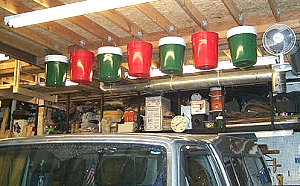
Misc Wiring Notes
We have had a few inquiries lately about wiring. I hope to have more about this in the future, but have thrown in the following to answer a few of the questions that have been asked.
Book: Inboard Motor Installations
Our book "Inboard Motor Installations" includes a chapter of Engine Electrical Wiring (Chapter 19). The chapter includes drawings of:
- Typical Ignition Circuit
- Typical Starting Circuit
- A Typical example of an ignition & instrumentation wiring diagram
- A starting circuit diagram (OMC)
- Marine Wiring Color Code-Direct Current Systems under 50 volts
Information on the web
The Ancor Products web site contains technical information for marine wiring, including a Wire Calculator. Fill in the following blanks in an on-line form and they will provide wire the gauge.
- Length in feet
- Current in amps
- System voltage
- Voltage drop
There is additional information in their Technical Information section such as:
- American Boat & Yacht Council (ABYC) Standards
- Technical Data
- Boat Cable vs SAE Wire
- Marine Color Codes
- Conductor Sizes
- Temperature Ratings
- Allowable Amperage
- FAQ
More...
Glen-L also sells Charlie Wing's book Boatowner's Illustrated Handbook of Wiring which is recommended on the American Boat and Yacht Council Site. The ABYC sets industry standards.
Feedback: Cabin Skiff
23 February 2003
Began 02-07-2002
Launched 09-21-2002
engine 50 4 stroke
capacity 28 gallons
speed 30 mph
range: 150+ miles
I added to the plans: an aluminum fuel tank, anchor box, foam and shelves on the sides, hydraulic steering and a outboard hydrofoil.
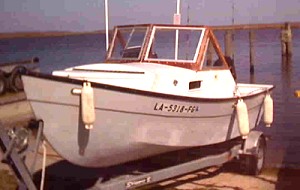
I think that this boat performs like a much larger boat. To try out the seaworthiness of the craft we crossed Lake Borgne, where military vessels are tested, during a small craft advisory, winds 30 knots and seas 4-6 feet. The boat and all three people on board remained dry. The skeg drags in the water when the boat rocks and you feel it as a paddle working under the boat. Also the bow is high so that no wave can go over, and the vee throws spray 30 feet to the sides when you knife through chop. Now, I can remain confident when I see those big yachts throwing eight foot waves right next to me.
I believe the range of the boat is over 150 miles. We will be able to fish all day without refueling. The cabin has enough room to spread out and keep your gear dry. I have slept comfortably in the cabin. There is plenty of power for the boat in a 50 hp, and a hydrofoil on there really keeps that bow down. I do not know if I am happier with the fact that I built it myself or that it rides so well.
In all, this is a real fine boat, it outperforms any open boat. It sure turns some heads. People call it 'cute'. I have had people take pictures of me.
Big Thanks Glen-L.
Regards,
Daniel F. Becker
Feedback: Noyo Trawler
Date: 2-2-03
Dear Sirs,
Way back in 1987 I had sent for Glen-L plans in order to build my own Noyo Trawler. I started building it in my garage in 1990 and it took me 3 years to finish it. Living on the Mediterranean island of Malta I wanted a durable boat which could be used as a family as well as fishing boat during the long summer season that we enjoy.
To build the boat based on your informative plans and instructions was not too difficult a task and I also had help from family members, who are in the boat building trade. We decided to alter the superstructure slightly and in 1993 we launched 'Freya'.
I am extremely happy with this very seaworthy boat and needless to say the Noyo is a boat of character. I have often been asked questions about it and people are astonished to learn that I built it myself. To date I have had 9 summers of family recreation on board 'Freya'.
Should anyone interested in building a similar boat wish to contact me, I am ready to answer any questions.
I shall also be sending some photos of my boat to you for you to put on the net.
Best regards,
Rennie Delceppo/ Malta, Europe
What prop?
Mercury Marine has a prop selector on their web site to help you determine the prop for your outboard motor. See: www.mercurymarine.com/prop_selector.
Recent email:
Subject: Vigilant photos
Date: 2-27-03
Hello Ladies and Gentlemen,
This is a very interesting and fun project for the year of 2002/2003. Try it!! Then you can share the fun.
To update (02/26/2003): nearly five months building VIGILANT, this is all I can produce.... a snail's pace. Looking back, without a previous wood working knowledge and very far away from Shipbuilding/Boatbuilding experience, I can consider myself one step a head from yesterday, from nothing to a small thing. In this project, every day is a new day with new experiences, quite interesting! Vigilant wouldn't have come this far without sooo much assistance from Gayle, Mr Barry Witt, your Naval Architect and your materials Warehouse operators at GLEN-L. Thanks to the gentlemen at GLEN-L'S Boatbuilding Forum, you are contributing all tricks in boatbuilding, slowly I grasp whatever necessary from the basic boatbuider knowledge in the Forum.
Please visit "Project Registry" to read the brief of the project. From the pics here send your comments, hopefully I can avoid making the same mistakes in the future. God willing, I will try to update the pics whenever the Fairing process and Planking work is completed.
Thank you very much for dropping by, thank you.
Haji Kamal
0310 hrs, 02/27/2003
Terengganu, MALAYSIA
Squirt-George Pugh-Springfield,Virginia--Feb 14,2003
Squirt for sale. I built my Squirt in l990. It is complete with a l992 Evinrude 9.9/15 outboard (bought new) and galvanized trailer(bought new l990). This boat has hardly been used and has been stored in my garage since it was built. My kids are grown now and I want to sell it to someone who will appreciate it for what it is. Asking $2300. Photo
Below is the result of your feedback form. It was submitted on Wednesday,
February 12, 2003 at 22:49:12
------------------------------------------------------------------------
name: Colin
Comments: I am especially interested in any reports on other people building the "Zip" boat. In particular any comments on how to rectify the problem of excessive drift when cornering at high speed mentioned by other builders.
Answer: See WebLetter 41, Designer's Notebook: Skeg Vs. fin.
Bob has been building the Jack Tar and expects to launch at the Royal Victorian and Albert Dock, on the river Thames in London this spring. The boat launch will be featured in "Watercraft" magazine. The village is Hunsdon, and construction has been closely watched by the local residents.
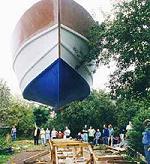
Subject: MUMMYSUE
Date: 2-12-03
Dear all at Glen-L
Just a short note. MUMMYSUE, had her first British Boat Safety survey last Saturday, which covers every aspect of the building, Hull, Electrics, Gas Installation, every part of the Boat was inspected. The surveyor, was so impressed with her fine looks and sturdy features, he actually stated that in all his twenty six years as a Boat Surveyor, he had never surveyed such quality from self-built.
I am very happy at the moment, oh sorry... she passed with flying colours, with admiration for the designer. I had to rush on the Telephone to my Insurers, and raise my coverage five fold.
P.S. The reporter from WATERCRAFT, is staying over at our house this weekend to begin the story, with pictures of MUMMYSUE. I really cannot believe all the attention, the Village is Buzzing with excitement.
Friends, take care, OK?
Best Wishes
Bob Warner, Hertfordshire England
26 February 2003
bob warner wrote:
To, Gayle & The Gang
What a lovely surprise, Sue was so chuffed with the caps and T-Shirts received today. We will wear them on "the" day. Thank you all very much and thank you for your support throughout my project building Jack Tar. Another thank you for your up-to-date Book of Boat Designs, very smart. Yes, a book of dreams as you say. I also realize that dreams can come true and when they do, there is so much that comes with that dream, an added bonus, friendship and the friends you gather during building that dream.
Dreams can be life altering, both during, and when it becomes a reality. Including yourselves, I have met and dealt with some really lovely and helpful people, who are now Sue's and my friends.
I am just now beginning to wake up, to realize, I have now two lovely girls to love, and look after.
God Bless, Take Care.
Bob
Below is the result of your feedback form. It was submitted on Monday,
February 03, 2003 at 17:54:08
---------------------------------------------------------------------
name: Bob La Londe
Comments: I just ordered the plans for a Jimbo. I'm really psyched about this boat. I would love to see project pictures from anybody who is or has worked on one. I would also really like to see overhead pictures of the layout of fixtures, seats, etc inside the boat.
Can anyone help Bob?
Below is the result of your feedback form. It was submitted on Saturday,
February 01, 2003 at 17:57:54
-----------------------------------------------------------------------
name: Sandy
Comments: was here looking for plans for a wooden windshield. Nothing here of
any help.
I know several builders have made their own wooden windshields... anyone want to share? ...barry
Subject: RE: Glen-L Update - Happy Holidays from Montreal
Date: 12-22-02
Happy Holidays and thanks for the recipes in your webletter 42. I purchased
a Glen-L TNT kit last fall for my boyfriend and Dad. Just watching them putting
it together is entertainment enough. In my book, the project is already a great
success. We hope to launch the boat (yet to be named) when the lake thaws out
in the spring of 2003. Will keep you posted...
Kindest regards,
Louise Houle
Montreal Canada
Build more boats
GLEN-L boats, of course